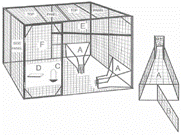Eastern Wildlife Damage Control Conferences
Date of this Version
October 1997
Document Type
Article
Abstract
Agricultural damage by wildlife is a major concern for both agricultural and wildlife agencies at the state and federal level. Our objective was to estimate wildlife damage to agricultural crops on a statewide basis. We sent questionnaires to 4,958 farmers and 1,003 were returned after 2 mailings. Twenty-five percent of farmers responding to our survey rated the level of wildlife damage to their crops as severe or very severe, 46% as moderate, and 29% had none or very little. Mean levels of crop loss to wildlife ranged from 6% for wheat to 10% for corn grain, and white-tailed deer (Odocoileus virginianus) were the most commonly reported cause of damage for all crops except soybeans. Farmers estimated the economic value of damage caused by wildlife to 6 crops (corn grain, silage, alfalfa, soybeans, oats, and wheat) as > $70 million. Ninety-one percent of Pennsylvania farmers allowed deer hunting on their farms, but 62% of the farms were bordered at least partially by land that was posted (no hunting or limited hunting). Fifty-six percent of farmers whose land was bordered by posted land believed adjacent posted land made it difficult for them to control deer numbers and damage on the land they farmed. Thirty-one percent of farmers responding to the questionnaire reported that they had changed farming practices (i.e., no longer farmed a particular field or raised a particular crop) as a consequence of deer damage. Additional methods used to control deer damage included shooting (28%), chasing (13%), fencing (9.3%), repellents (7%), and noise devices (5%). Fencing and shooting were the only methods rated as being at least moderately effective.



Comments
Published in Proceedings of the Eighth Eastern Wildlife Damage Management Conference, Roanoke, Virginia, October 16–19, 1997, edited by James A. Parkhurst. Copyright © 1997 by the authors.